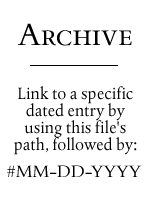|
|
|

|
 December
31, 2006: Must Run Dogs December
31, 2006: Must Run Dogs
New Year's Eve, and I don't feel much like doing any sort of recap
on our soon-to-be-defunct year—and lord knows, I'm not going
to embarrass myself by crafting a list of cockamamie predictions.
("Big Media will continue to inflate Barack Obama so he can
act as Condi insurance in 2008." Yeah, and the atomic weight
of Ytterbium will continue to be 173.04.) The dinner table has been
cleared, and the family here in Crystal Lake is about to put on
Must Love Dogs,
a romantic comedy starring Diane Lane and John Cusack that is another
film in the genre of "breathtakingly beautiful people who simply
cannot get a date."
Ok, I'm a little grumpy tonight. I'm severely annoyed at Windows
XP Tablet Edition, which is all I have to work with on this trip.
I haven't quite had the Thinkpad X41 Tablet for a full year, but
I've had it long enough to have given it a good shot, and for anything
but reading ebooks I really dislike it. Here are my major gripes:
- It's ponderously slow. Even though the little tombstone has
a 1.5 GHz Pentium in it, the system feels no faster than my 1998
Dell Dimension P550 running basically the same 1999-vintage apps.
(Yes, I understand that this may be due to system software installed
by Lenovo, but I'm not absolving MS of all responsibility.)
- It becomes unstable very quickly compared to my other
systems running Windows 2000 and even Windows XP. After 24 hours
of uptime, truly weird things begin to happen, like my taskbar
going away and refusing to come back.
- There is a bizarre Z-order bug in the UI that shows up regularly:
Flyover help balloons for icons in the taskbar appear behind
the taskbar, and you only know they're there because you can see
the tops of the balloons peeking up over the top edge of the taskbar.
- The mouse cursor stutters and sometimes just stalls, for seconds
at a time, while the underlying system performs inexplicable tasks
that simply must have priority over the mouse driver. (My
view: Mouse cursor interrupts take priority over everything.
Period.)
- The keyboard misses keystrokes when I type quickly. Again, I
suspect that something is getting cycles before the keyboard interrupt
and causing a loss of keystrokes.
- The X41's handwriting recognition system cannot recognize my
own last name, no matter what I do or how neatly I write it. Once
I figured that out, I simply stopped using it, and did not explore
further.
Some of these, to me, are firing offenses: Programmers who can't
avoid Z-order bugs in UI code need to be fired, blacklisted, and
forced to stuff pantyhose into racks at Wal Mart for the rest of
their lives.
I've heard (but have not been able to confirm) that the UI for
Tablet Edition was written in .NET. If this is the case, it's not
an especially compelling demonstration of .NET. Standard XP can
run for many weeks without becoming unstable, even with a whole
raft of installed apps. Win2K can go for months, especially if you
degunk it regularly, as I do. This system is actually pretty spare
in terms of installed apps, and there's no malware on it. In fact,
most of these behaviors began to occur as soon as I took it out
of the box.
Recent articles indicate that Windows
Vista basically destroys the digital media village in order to protect
it, and that its product activation system is hugely more paranoid
than XP's. No way am I going there. Linux isn't finished yet (and
it really should be further along now than it is) and the Mac user
interface isn't nearly as good as its fanboys claim it to be. A
single-button mouse is inferior to a two-button mouse, and even
though the Mac OS now supports two-button mice, most of the apps
themselves do not.
UI issues like this are fundamental because they are the interface
between my skills and the computer. There is a sort of conceptual
grammar implied beneath all user interfaces, and context menus add
a richness to that grammar than I am unwilling to abandon. Basically,
a UI without instantly accessible context menus is a language without
pronouns. I will admit without apology that the unbelievably condescending
arrogance with which Apple defended its use of a one-button mouse
back in the 80s continues to irritate me. ("Our users are too
stupid to figure out more than one mouse button. We're the UI Gods
of the Universe, and we have declared this to be a physical law.")
Finally, many of the apps I use daily and make my living with do
not exist on anything but Windows. (Visio is probably the most important
one of these.)
So I'm stuck with Windows. Hey, how about a movie called Must
Run Dogs, about a bunch of average-looking but farly bright
people who simply can't find a decent OS? It could become the biggest
grosser of 2007.
Whoops. Movie's on. Rant off. Happy New Year. Don't worry about me;
I'll feel better once I have Win2K back again.
|
 December
30, 2006: Odd Lots December
30, 2006: Odd Lots
- I'm looking for something (ideally a Web app, but a Windows
client will do) that will display a 3-D representation of our
immediate (within 100 light years) stellar neighborhood, with
Sol at the center. Pan and zoom would be socko. I don't recall
ever seeing such a thing, but it's an obvious thing to do and
could be very useful on a number of fronts.
- I'm also looking for a map indicating how our planet would appear
if all (or most) of our polar ice were to melt. How much land
would really go underwater? I'm pondering an interesting SF gimmick
that depends on the existence of a lot of land that's just barely
underwater.
- Slashdot aggregated a BBC article summarizing 100
Things We Didn't Know Last Year. Most are deep trivia rather
than science ("The Cowardly Lion's costume was made from
real lion pelts") but some did surprise me a little. ("A
common American poplar tree has twice as many genes as a human
being.") Helen Mirren (certainly my favorite actress) was
born Ilyena Lydia Mironov, which might account for her delicious
Russian accent when she played the Soviet spacecraft captain in
the film 2010. Camel's milk contains ten times the iron
that cow's milk does. A third of all the cod fished in the world
is consumed in the UK. Etc.
- Budget a little time for The
Museum of Bad Album Covers. Mostly this is a referendum on
the Seventies, but it's a pants-wetter nonetheless.
- My friend Greg Singleton "collects" over-the-top Christmas
decorations, and this
one gets some kind of award for mixing mythic metaphors. There's
one here in Niles that I must snap before they take it down, which
gets points at least for cold (not hot) air, and I'll present
it soon if it's still there.
- "Santa Baby" was written by Joan Javits, with music
by Phil Springer and Tony Springer, circa 1952. Eartha Kitt put
it on the map in 1954, in an early Mel Brooks musical show called
"New Faces" that was really a loosely connected series
of comic sketches. So it was a joke from inception. Whew. (Thanks
to Rich Rostrom for locating that one for me.)
|
 December
26, 2006: "But, Miles, It's Full of Garbage!" December
26, 2006: "But, Miles, It's Full of Garbage!"
Carol and I try to be practical and a little bit spare when it
comes to Christmas presents. We're not hung up on surprise; we'd
rather request things from one another and not have to guess about
wants and needs. This year, my list was short—I basically have
everything that one man might need—but I asked Carol for something
I stumbled upon online: A signed and dated Strathmore reprint of
what I consider the
funniest and most cogent cartoon ever penned by a human being.
Humanity, it seems, could be divided into two groups along the
lines represented by John Caldwell's pigs: Those who can see it
coming, and those who can see it coming but bite anyway. It's an
interesting gulf, and I've counseled more than one Miles on what
a poke looks like. The interesting thing is that all too many people
know certain things (or people) are damned well bad for them, but
simply can't resist.
I received another present from Carol that I'm delighted with and
will discuss here once I take it apart and look at its innards. Certain
things just beg to be hacked, and this is one of them. More later—when
I'm home and have access to a full set of small screwdrivers.
|
 December
25, 2006: Merry (Belated) Christmas! December
25, 2006: Merry (Belated) Christmas!
I'm still in Chicago, and, as always, connectivity isn't pervasive.
So I'm a little late posting but let that not detract from the best
wishes that Carol, QBit, and myself offer you in this blessed season.
Jesus Christ came to us to heal and restore all people and all things,
not to judge, condemn, and torment the bulk of us in Hell. That's
the Manichaean heresy talking—and alas, it speaks very loudly
in Christianity today.
Don't listen. Instead, believe in a benevolent God, love those around
you—even the ones that drive you nuts—and maintain hope
against the pains of this small present moment that in the final chapter,
all manner of thing will be triumphantly, gloriously, outrageously
well!
|
 December
23, 2006: Libraries, Bookstores, and Espresso December
23, 2006: Libraries, Bookstores, and Espresso
Slashdot aggregated a short piece on CNN about Espresso, a one-book-at-a-time
machine that I
have commented on before—five years ago, in fact. So the
book machine itself is not news—and similar systems were around
before Jeff Marsh announced Espresso in 2001—but this time,
the innovation is to put the machines inside public libraries, basically
as dispensers of printed copies of out-of-copyright books. (See
ondemandbooks.com.) People have
been talking about machines like this in the back rooms of bookstores
for a long time, and I posited "replenish-on-demand" book
retailing in my October
16, 2006 entry. None of that is especially new or novel, though
the little
video clip of the Espresso machine in action is worth a few
minutes to watch.
(One caveat I have: The machine has been announced for five years
and is still in "alpha"? This sure sounds like an underfunded
basement operation to me, and the machine looks like a slightly
haywire lashup of two commercial printers with a binder. This
is about all there is on the Web.)
What may be worth pondering is having book-on-demand machines in
public libraries, fed by archives like Project Gutenberg. And that's
just to get the library systems installed, funded, and used. What
happens next might ignite the War to End All Wars in bookselling:
Allowing public libraries to sell POD copies of first-run books
by contract with publishers. Figure that certain people will take
a book out of the library, read it, and then like it enough to want
a copy of their own, or one to give as a gift. As a publisher, I'd
be delighted with such a system, and I suspect most small-to-medium
sized publishers would as well. The war would begin when book retailers
realized that libraries are publicly funded organizations and could
sell books at very steep discounts. Large publishers don't dare
annoy large booksellers, on whom they depend. Small publishers don't
get much shelf space in retail stores anyway, so they take sales
however they can. A library-based network of unattended POD kiosks
would (at least potentially) be a huge threat to booksellers,
and their point is worth discussing: Should a government agency
compete with private retailers?
I'm on the fence here. It's good to give the public more choices,
and retailers cannot stock everything. (They won't stock my novel,
for example. Hrmph.) Libraries should be allowed to do anything permitted
under copyright law. If the bookstores don't like it, well...their
recourse is obvious: Get machines themselves, and "stock"
everything. Everything. No exceptions. Everything.
|
 December
20, 2006: The Worst Christmas Songs Ever December
20, 2006: The Worst Christmas Songs Ever
A few days ago, Michael Covington posted a note with a
list of what he considered the worst Christmas songs ever. I'd
like to add a few entries to the list while I have a spare moment
here:
- "Santa Baby" by Kylie "Who the hell is that?"
Minogue. If ever there were a more loathsome piece of music connected
with the Christmas holiday, I've yet to hear it, and suspect such
a song might violate one or more of the laws of physics.
- "It's the Holiday Season" by Frank Sinatra. "So
whoop-de-doo / And dickory-dock / And don't forget / To hang up
your sock..." Pass the barf bag, and could we please consign
this talentless moroon to the dustbin of history?
- "Grandma Got Run Over By a Reindeer" by Elmo and Patsy
Trigg. This was a little funny the first time I heard it, but
in the slightly painful way that having your first shot of Drambuie
is interesting while making you reluctant to have another. And
having heard it countless times since then, I start wanting to
throw things every time it comes on the Safeway Muzak channel.
- "Jingle Bells" by Barbra Streisand. You know, the
version that goes so fast that you start fearing, then hoping,
and finally praying that she will hyperventilate and pass out
cold.
That's the short list, and I'm out of time this morning. If I think
of any others I will post them here.
|
 December
19, 2006: Whew December
19, 2006: Whew
After three days or so without posting here, my readers start sending
me anxious emails: "Is something wrong?" Well, generally
not, but this time there were some things working against me. It
was a busy trip from inception. We postponed a lot of our Christmas
shopping until we got out here, so we wouldn't have to ship loads
of presents from Colorado. That alone has managed to soak up a huge
amount of time and energy.
Katie Beth's christening on Saturday night went off without a hitch,
and we had a delightful time over at Gretchen and Bill's during
the party that followed. The sacrament was confected right on the
kitchen table, by our Old Catholic priest friend Mary, who also
said our 25th wedding anniversary Mass back in 2001. Mary blessed
the water in the lead-glass basin that dates back to our grandmother
Sade's wedding shower in 1919, and then scooped the water up in
a sea shell to pour it over Katie's head three times, baptising
her in the name of the Father, and of the Son, and of the Holy Spirit.
Katie didn't fuss—in fact, she smiled and made happy-sounding
baby noises throughout. Most infants fuss at their baptisms because
the water in the fonts is at room temperature—probably in the
high sixties in most drafty churches—and we were careful to
keep the water at skin temperature or a little warmer, at Mary's
direction. A priest who has also been a mother: Who else would have
had that insight?
Carol and I pledged to keep her on the path, and we will. (Dare
I attempt a short children's book on the Great Message of Lady Julian
of Norwich? That God will never settle for half a loaf, and that
ultimately all manner of thing will be well? Katie will certainly
provide me plenty of motivation.)
Alas, there was something a little dicey about the catered-in Italian
dinner, and several people in attendance got from mildly sick to
quite sick the next day. Bill and Gretchen took the worst hits,
but it slowed me down a little too. Fortunately, it didn't seem
to go much beyond the three of us. Unfortunately, what we all saw
as several days' worth of yummy leftovers went down the disposal.
Carol and I have managed to visit with a couple of friends as well
as immediate family, and we hope to see a few more before we head
back home. My postings here may be a little sparse for several more
days, as I don't foresee much quiet time here in the basement with
the DSL connection. Of course, Carol's right when she says that we
didn't fly a thousand miles for me to hammer on a keyboard. So bear
with me. All is well.
|
 December
15, 2006: Katie Beth Makes an Impression December
15, 2006: Katie Beth Makes an Impression
In Chicago, and earlier this evening I did something I hadn't done
in literally 26 years: Held a baby. We finally got to meet Katie
Beth Roper, daughter of my sister Gretchen and her husband Bill.
Katie is certainly the most placid and well-behaved newborn I've
ever spent any time with. The last time I had any close contact
with babies was in 1980, when I held my high school locker partner
Tom Barounis' firstborn, who was a couple of months old at the time.
I was afraid I would drop little Tim (who, by the way, is now a
newly minted physician) or in some other way damage him, and Carol
teases me about it to this day.
Not a problem with Katie. Gretchen sat me in one of their easy
chairs and dropped Katie in my lap. I was expecting her to either
scream, throw up, or both, but lo! She leaned back, yawned, and
went to sleep, gripping my index finger in her very tiny right hand.
So I leaned back and contemplated godfatherhood for a moment, with
the side thought that babies are nice and warm. It wasn't until
dinner was ready and Gretchen scooped her out of my lap to put her
in her crib that we realized that the warmth was a passing thing.
Katie had just had a different sort of garment malfunction. Gretchen
was trying out a new brand of diapers that wasn't, in fact, the
best fit, and, well—was I so naive as to think that the baby
business wasn't messy?
Yes, my niece peed on me. In fifteen or sixteen years, when we're
visiting and she has her boyfriend with her at dinner, I will tell
the tale with some relish. And then (doubtless) I will be wearing
the relish. No matter—it stains less than ketchup.
|
 December
14, 2006: Calendars on Lulu December
14, 2006: Calendars on Lulu
I'm heading off to Chicago later today to witness our new niece's
baptism, but before I shut down I wanted to report on another Lulu
publishing feature that I tested: Calendars. In addition to books,
music, and other digital downloads, Lulu allows you to publish photo
calendars as well. So to give it a roll I gathered twelve of my
best QBit photos, and created a QBit 2007 calendar.
As with books, Lulu publishes calendars through a wizard that asks
you questions, prompts you to upload your content (in this case,
12 high-res photos, with captions) and then crunches the material
into a finished, printable PDF. You can then review the PDF, and
order a printed copy (at cost) to see how it will look in physical
form. I don't have the printed calendar yet (it will be waiting
for us in Chicago) but the creation process is straightforward and
the PDF looks very good.
You have the option of including any of a list of holidays and
celestial events (basically, phases of the moon) as well as purely
custom notices like family birthdays or the anniversary of Apollo
11's landing on the Moon.
Some minor quibbles:
- The photos should be of a 3:4 aspect ratio, which is how most
cameras take them. Nothing in Lulu's doc mentions this; I found
out when I cropped a few photos and found that they were clipped
if they were too high, and left whitespace if they were too long
and not high enough.
- Although they allow you to upload a single binary preview file,
what the system really needs is a way to generate (on the server
side) a single thumbnail of the 12 calendar photos. This is not
rocket science, and I've sent them the suggestion. I haven't had
the time to create the thumbnail file myself, but in truth readers
of Contra will have seen most of the photos already.
- The calendars are expensive. Their base manufacturing cost is
$19.95, and if you want to make a profit you must sell them for
more than that. Color ink is not that hideously expensive to make,
but the printer companies have clearly staked it out as their
primary profit center.
Although I didn't intend to make the calendar public (we're giving
them to family members for Christmas) I made it public anyway, and
you can see it on my Lulu
storefront. Overall, a very cool system, and I think it may be
the first system ever to integrate custom calendar creation with a
Web ordering and fulfillment system.
|
 December
12, 2006: Odd Lots December
12, 2006: Odd Lots
- The leading names for our new puppy so far are Comet and Captain
Nemo. Both names are pertinent: A comet, after all, is a dirty
snowball, which the little guy resembles after rolling in the
dirt. Also, we could then say, "Comet and QBit" to precede
"Donner and Blitzen." Alas, the most natural diminutive
to "Comet" is "Commie." (Some people have
already called QBit QBie. Commie and QBie. Maybe not.) We considered
Elf, given that he's a Christmas puppy, with the bonus after-the-fact
acronym of "Extremely Lovable Furball." Captain Nemo
works well because anytime he sees an available lap, it's Dive!
Dive! Dive! He also has a desire to wander, rather like Pixar's
defiant little fish of the same name. QBit always stayed right
beside us, but the little guy clearly wants to explore. I can
see it now: 20,000 Leagues Off-Leash.
- Pete Albrecht sent me some links on the
Curta Calculator, which I had heard of but never seen or read
about in detail. It's a thing about the size and shape of a pepper
mill, with a crank on the top. You enter numbers on little sliders
on the device's side, and then turn the crank to generate a sum
or a difference. (Other arithmetic operators can be accomplished
with a little more work.) There's even an online Curta
Simulator, which will give you a much clearer picture of how
things work. Now I know why people say, "crunch the numbers."
Also, it was made in Liechtenstein,
of all places.
- I received the "big" (non-free) edition of Turbo Delphi
a little while back, and have installed it and begun to test it.
It works beautifully, and (amazingly) may make me give up Delphi
6, or at least consign it to a VM. Whatever problems I've had
with Turbo Delphi so far have to do with the installation of all
the .NET folderol that it requires as prerequisite installs. Partway
through the .NET installation on my new XP machine (the SX270)
it asked to reboot, and when I did, the Administrator account
(from which I had begun the install) was no longer listed on the
Welcome screen, but only the Jeff Duntemann and the Jeff (Limited)
accounts. I could still log in as Administrator, but I had to
turn off the Welcome screen and log in via the command-line dialog.
WTF?
- One thing I didn't know until yesterday is that Turbo Delphi
requires activation. It's not like XP or Adobe activation in that
I don't think it looks are your hardware and hunkers down when
you change a hard drive or network card, but that is an experiment
I do intend to make.
- Sectorlink, my hosting service, has apparently turned off their
spam filtering mechanism because it was being overwhelmed by recent
floods of spam. That we're being carpet bombed with the stuff
is clear: I got 306 spams yesterday, after over a year of getting
maybe 75 or 80 per day. As I write this, it's 10:15 AM and I've
already gotten 133 since shutting down last night at 10. Most
of the delta is pump-and-dump scams using only images and some
obfuscation text. Thunderbird's trainable spam filter is basically
worthless, and gets only about 40% of what comes in. I nab ten
or twelve spams per day with a conventional keyword filter, but
what we really need (as Michael Covington has suggested) is a
more general filtering language that would allow us to compare
strings in From and Subject, and count attached images and measure
their size, etc. I really don't think that most people care about
spam, because things as obvious as that are just not being done.
|
 December
10, 2006: Introducing..um..the Puppy with No Name December
10, 2006: Introducing..um..the Puppy with No Name

Ok, I'll have to admit it: Having Dino over here with us for a
couple of weeks was a kind of test. We were trying to see how QBit
would react to having another bichon around the house. And the two
of them had such a good time tearing around the place together (and
sacking out in a pile when they got tired; see my
entry for November 27, 2006) that we figured it was a go: We
would add another puppy to the mix. So yesterday afternoon, Jimi
Henton drove up with her six available puppies, to allow us to choose
the one we wanted.
We closed off the laundry room from the rest of the house and just
let them all run around. It was puppy pandemonium for a solid hour,
and that all by itself was great fun. Carol very much wanted a lap
dog, so we sat on the floor and paid very close attention to which
puppies crawled into our laps unbidden. QBit is very playful, but
he's not a natural lap dog and prefers to sit on the back of the
couch, ideally where he can lick the top of my head. He's also on
the big side (now 16 pounds 8 ounces) and we hoped our second would
be smaller, more like Dino.
Of the six puppies, only three were lapseekers, and of those three,
one stood out: If there was a lap available, he would make a beeline
for it. He was also the smallest male of the litter, now four months
old. Unlike Dino, who was a little skittish and seemed afraid of
me, even after three weeks in the house, the littlest puppy actually
seemed to prefer sitting in my lap to doing anything else. Another
hour and Carol and I nodded to one another: He was the one. After
Jimi packed up all the others (along with Dino) and went home, we
immediately gave our new puppy a bath and brushed him. He has a
much worse tear staining problem than QBit did, but that's a treatable
condition, and tends to get better as the puppy matures.
We're still stuck for a name, but we're working on that. In the
meantime, here are a couple of pictures of little What's-His-Name
to get you started. At some point I'll add an album to my online
photo gallery, but for the moment I'm thinking of him as Our Christmas
Puppy. We're going to have to give him back to Jimi while we're
in Chicago unless I can figure out a way to get him there, but for
the moment, empty laps are scarce around here, and that's the way
it should be.


|
 December
8, 2006: More on the Dell SX260 and SX270 December
8, 2006: More on the Dell SX260 and SX270
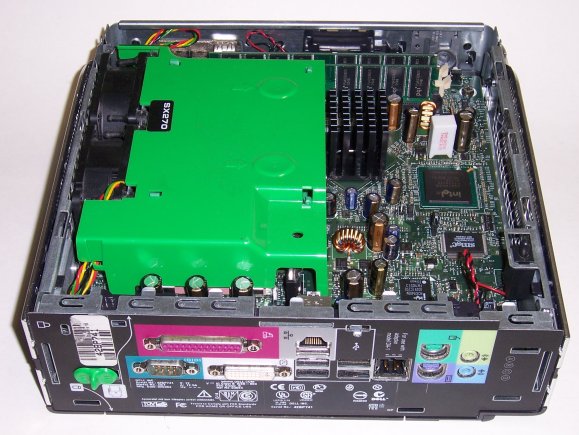
Getting at the insides of a Dell Optiplex SX260 or SX270 (the two
differ only in the type of video output they offer) is a snap—once
you know how. There's a little green latch lever on the back panel
(lower left corner of the photo above) that works two ways: Push
it to the left, and it opens the internal disk drive hatch on the
bottom of the machine. Push it to the right, and you can slide the
top side panel forward and off. With the panel off, you have easy
access to just about everything in the machine. The two memory slots
are at the very front, at the top in the photo. They will take either
one or two (identical) DDR SDRAM sticks, rated at either 333 or
400 MHz. The largest stick the box will take is 1 GB, giving you
a max of 2 GB RAM.
If you want a higher-res copy of the photo shown above, it's here.
The green plastic thing is a duct that guides air through the vanes
of the CPU heat sink beneath it. Two little thumb catches release
the entire fan/duct assembly, and then by disconnecting two four-pin
connectors, you can remove or replace the whole thing. (I saw a
retailer selling the fan assembly on eBay for $10. I may buy a spare
just to have it on the shelf.) I think the fan assembly differs
slightly depending on which CPU a given unit contains, with the
slower Celeron units having a 3-wire fan circuit, and the faster
P4 units having a 4-wire fan circuit. The extra wire may allow speed
control on the fans, which I know my two P4 units have. (I'm still
researching this.)
The BIOS button cell is mounted vertically and very easy to reach
and change if needed. (You can see it through a notch in the front-right
corner of the green duct in the photo above.) There's a very small
speaker mounted up against the machine front panel (it's the black
plastic item right behind the memory sticks in the photo) and it
has amazing volume for something so tiny, if not a great deal of
bass. The speaker slides right out after you release a thumb-catch.
Spares are available online.
I haven't completely disassembled either machine yet, but it looks
like five easily accessible screws release the motherboard.
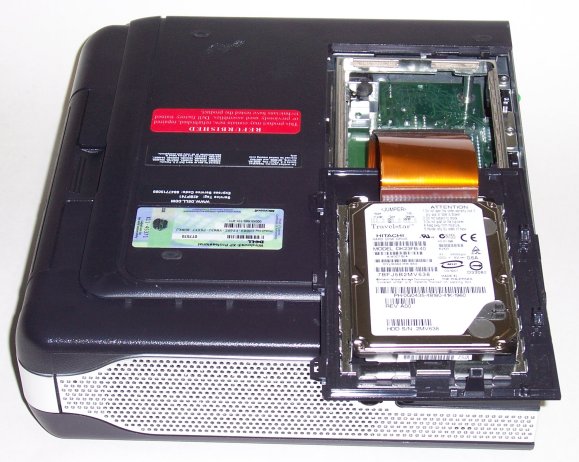
The other hatch on the bottom plate of the unit is much smaller,
and gives access only to the internal hard drive, which is in the
2.5" 9.5mm format. The drive is attached to a metal bracket
on the hatch cover with four small screws. A flexible ribbon cable
runs from the motherboard to the drive.
Overall, an impressive little machine for $250. (A friend of mine
just nailed one on eBay for about $150.) They're abundant on eBay,
and as they were designed to be fleet machines, I can only assume
that untold numbers are now coming off lease and are being dumped
on the market. (The higher-end units sold for $2000 a pop when they
were new in 2002 and 2003.)
This one will almost certainly become our media PC, though nothing's
going to happen until after Christmas. More later.
|
 December
7, 2006: Dell's C-Modules and the Optiplex SX270 December
7, 2006: Dell's C-Modules and the Optiplex SX270
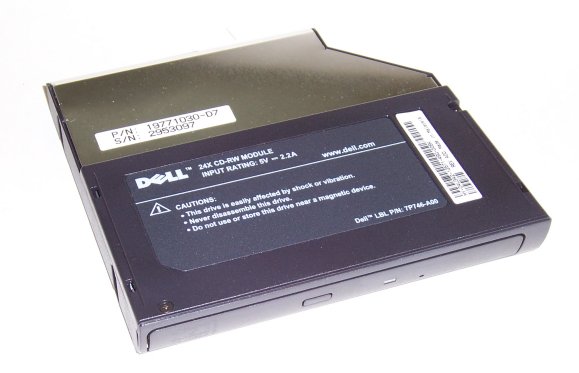
John Hall wrote to suggest that the Dell Optiplex SX-270 (see my
entry for December 2, 2006) might make a good media PC, and
it was certainly an idea that I had kicking around in my head when
I first saw the machines at work in our doctor's office.
Key to this application is an SX270 feature I didn't completely
grasp at first: The removable C-module. Originally designed for
Dell's full-sized laptops like the Inspiron and Latitude, the C-module
is a removable drive cartridge that can be popped out of the front
panel of the SX-270 and replaced with another. And so far, prowling
the Web and (especially eBay) I discovered the following different
species of C-modules:
- CD-R
- CD-RW
- DVD/CD-RW
- Zip 100
- Zip 250
- Hard disk caddy, either empty or containing drives of various
sizes
- An "airbay" filler wedge; i.e., a hole plug for the
bay
The photo above shows the CD-RW C-module that came with Carol's
new machine. With a DVD module, you could play standard DVD movies.
And with a 100 GB hard drive you could rip and store a fair number
of DVDs for display, or an almost infinite number of digital camera
photos.
The hard drives used in both the internal drive mount and in the
C-modules is the 2.5", 9.5mm format. The drives in the two
machines I have here are Hitachi Travelstar drives, both 40 GB.
Hitachi now makes them up to 160 GB in capacity, and I suspect other
drive manufacturers make them as well.
I don't know as much about media PC technology as I need to, and
I'll be researching it in coming months. I don't watch much TV,
and almost never anything worth recording, at least since Firefly
sank a couple of years ago. However, I want to be able to play MP3s
through our stereo amp and ceiling speakers, and show our digital
camera pics (and short video snippets) on the TV. The SX270 should
do that all with ease.
The SX270 (and I presume the SX260, which is identical except having
VGA video output instead of DVI) field-strips easily, reminiscent
of IBM's PS/2 Model 50, which came apart like Legos at need. I'll
have some more photos tomorrow.
|
 December
5, 2006: Odd Lots December
5, 2006: Odd Lots
- Pertinent to my
entry for November 25, 2006: A
US district court has ordered the Treasury Dept. to modify American
paper currency to make the denominations distinguishable by
the blind. They do this in Europe and a lot of other countries,
and although making bank notes different sizes sounds a little
dicey to me, there are many other things that could be done. And
this would be a great excuse to retire the dollar bill
and create a diameter-distinct dollar coin that people might even
use.
- Rather than spin off their developer tools division to a group
of investors, Borland
is creating a wholly owned subsidiary called CodeGear to sell
their compiler tools and manage their future evolution. The
FAQ on the move is interesting more for what it doesn't say
than for what it does: Borland needs their compilers, probably
more than their compilers need Borland. I'm hoping for the best,
and having just received review copies of the "big"
Turbo Delphi and C# products, I think some hope is warranted.
- Google
Answers is shutting down after four years of charging people
$2.50 to ask questions of experts. The basic idea is sound, but
I wanted more confidence in the expertise of Google's experts—and
in truth, the questions that puzzle me are not things that experts
can generally answer.
- The Dell Optiplex SX270 (See my
entry for December 1, 2006) has something I didn't notice
at first: An external drive bay designed for a "poppable"
module, and there's a button on the front panel that when pushed,
pops the module (generally an optical drive) right into your hands.
There is a lock lever inside the case to keep passers-by from
popping and walking off with your drive, for the cube-farm market.
The two units we have here include CD-R drives, but DVD and DVD-R
drives are available (as well as a floppy drive and a conve tional
hard drive) and it would be interesting to find a five-way memory
card/stick reader in that module format. The more I use this item,
the more I like it. Heat (as warned by some online reviews) has
not yet seemed to be a problem.
- This morning's Wall Street Journal reported that Jones
Sodas is dumping high-fructose corn syrup and going back to cane
sugar. (Here's
a link to an online piece in the Seattle Post-Intelligencer)
Dare we hope that this will become a trend?
- I got a slightly indignant note from one of my readers (and
he may or may not have been pulling my leg; it's hard to tell
with some guys) informing me that "Texas Elegance" is
not a porn star, but rather a nude model. (See my
entry for November 28, 2006.) Furthermore, she is only 48.
She works for a porn site called Southern Charms. And she's "hot."
Just FYI.
|
 December
4, 2006: Derivative Works and the Public Domain December
4, 2006: Derivative Works and the Public Domain
A couple of people wrote to ask how I could copyright a book originally
published in 1875 and now in the public domain. (See my entry for
November
30, 2006.) That's an interesting question. What I'm really doing
is creating a derivative work based on The New Reformation
but not absolutely identical to it, and the derivative work is what
actually falls under copyright.
It's not just the words that are copyrighted in a book. The design
and layouts are as well, along with any changes that the new publisher
makes to the original material. I didn't do any strong edits to
the text, and certainly none that affect what the author is saying,
but I fixed a couple of typos here and there. I also changed some
of the British spellings to American equivalents. Put the word "gaoler"
in front of a typical American, and dimes to doughnuts the American
will say that it's a misspelling of something else, or a nonsense
word. (MS Word's spell checker doesn't understand "gaoler"
and suggests "galore" instead.) I also replaced a lot
of dipthongs where we don't use them anymore, particularly in the
word "Ecumenical," which used to be spelled "Œcumenical."
(I left the dipthongs in the quoted Latin, where the scholarly usage
hasn't changed much in the last, oh, nineteen centuries.) Finally,
I created a modern table of contents and index for the book.
All of this took time and effort, but made for a book that is more
easily read than your typical "holograph reprint," which
is basically a photostat of the original ancient pages, with all
their rips, blotches, wrinkles, marginal scribbles, and squashed
bugs. I'm not a fundamentalist about copyright, but I don't want
one of the other book-rescuers in the business to just lift my edition
of The New Reformation and add it to their lineup.
I've kept my original copy of The New Reformation (though the
book is now in pieces, stored in a plastic bag) as well as a notefile
indicating what changes I made to the text. If a mysteriously modern
edition of The New Reformation appears someday with most (but
not quite all) the diphtongs removed, well, I'll be able to make a
good case that it's been pilfered. Not that I'm worried—the worldwide
lifetime market for the book may well be in the low three figures—but
I'm a publisher, and I know at least a few of the tricks.
|
 December
2, 2006: Small, Quiet, Cheap: Choose Three December
2, 2006: Small, Quiet, Cheap: Choose Three
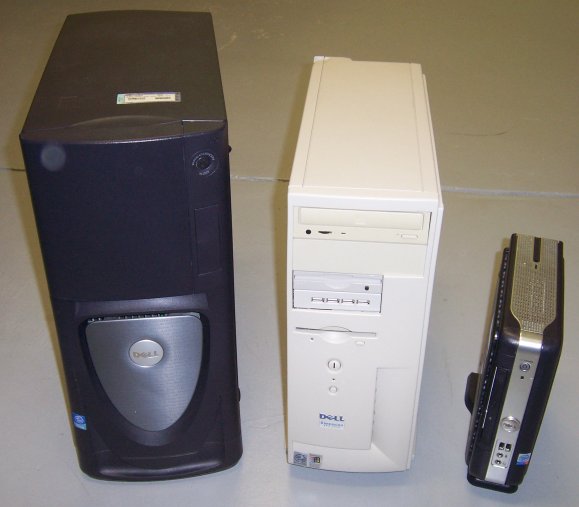
The last two times we were up at our doctor's office, I found myself
leaning against the counter, admiring the cute little machines the
office people had. After asking, they let me look a little closer,
and I wrote down the model number while listening to them. "Is
this thing on?" I asked one of the clearly puzzled young women
at the reception desk.
It was as close to silent as any PC I've ever seen with a fan in
it.
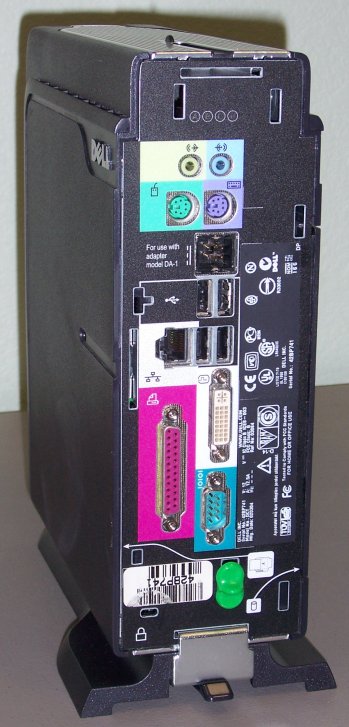 The
model was the Dell
Optiplex SX270. I did a little sniffing around online, and then
swallowed hard and ordered a used one from a vendor on eBay. For
$250 I got a 2.8 GHz P4, 512MB, 40 GB mini-box with CD-R drive.
It was used, and used hard (dents, scratches, goop from removed
corporate inventory tags) but I booted it up and it worked like
a champ while making so little noise I had to bend down within a
foot of it to hear it at all. The
model was the Dell
Optiplex SX270. I did a little sniffing around online, and then
swallowed hard and ordered a used one from a vendor on eBay. For
$250 I got a 2.8 GHz P4, 512MB, 40 GB mini-box with CD-R drive.
It was used, and used hard (dents, scratches, goop from removed
corporate inventory tags) but I booted it up and it worked like
a champ while making so little noise I had to bend down within a
foot of it to hear it at all.
The photo above shows the Three Dell Bears: Papa Xeon, an insanely
big and heavy 1.7 GHz box from 2002 that is mostly empty air inside;
Mama Dimension, a P-550 I've had since 1998, and arguably one of
the best machines I've ever owned, and Baby Optiplex, which is almost
five times faster than the Dimension while about one-sixth its volume.
And quieter.
Quiet matters to me as I get older. I've never run loud music while
doing technical work (I used to listen to music while writing SF,
but I don't even do that anymore) and concentration seems more difficult
in your fifties. The Xeon sounds like a jet engine, and even the
modest purr of the Dimension is intrusive when I'm trying to get
a grip on a difficult concept. Last year, Pete Albrecht and I built
a very quiet 3 GHz machine from loose parts with the guidance of
Bob Thompson's superb book Building
the Perfect PC. The Antec Sonata case is wonderfully quiet,
but the Optiplex is damned near silent.
Above is a close-up back view, so you can see the port lineup.
Note that there is no VGA video output. Video is DVI
only, though outboard DVI-to-VGA adapters are cheap. There is one
DB9 serial port, and a DB25 parallel port, plus six (count em!)
USB 2.0 ports. Conventional mouse, keyboard, and sound jacks, plus
a Gigabit Ethernet port. Not too bad.
I found after installing some software and working for awhile with
the SX270 that the fan runs a little harder when you're doing something
compute-intensive, but even at its loudest, the noise of my machine-gun
keyboarding drowned it out. And when the CPU load drops, the fan
speed drops too, back to that delicious near-silence.
After leaving it run for over a week without incident, I ordered
a second unit (in much better physical shape) for Carol to use,
in place of her very noisy and increasingly erratic machine. For
$375 I got a 2.66 Ghz P4 version with 1 GB of RAM and CD-RW drive,
in excellent condition, with all the recovery CDs, manuals, and
even the cardboard box it came in. Included in the package was a
metal bracket that can be used to hang the machine under a table
or a cabinet. The vendor handled the transaction beautifully, and
I recommend them: Moy Networks.
Both machines came with XP SP2, but because they don't have any
internal hardware expansion options, I won't have trouble with Windows
activation by changing out hardware. And the unit I bought for myself
will actually become my XP lab machine, and the Dimension will go
on the shelf as a spare. My daily work will continue to be done
under Windows 2000.
I haven't opened up the Optiplex yet to see what's all inside it,
but based on a couple of weeks' sporadic use I think I can recommend
it as a good, cheap, quiet, small machine with a lot of mounting
options and six USB ports. For $250 I consider it disposable; if
it croaks within a year I'll just get another.
The lesson here? Pay attention when you go to the doctor. Not everything
good is on the shelf at Best Buy.
|
|

